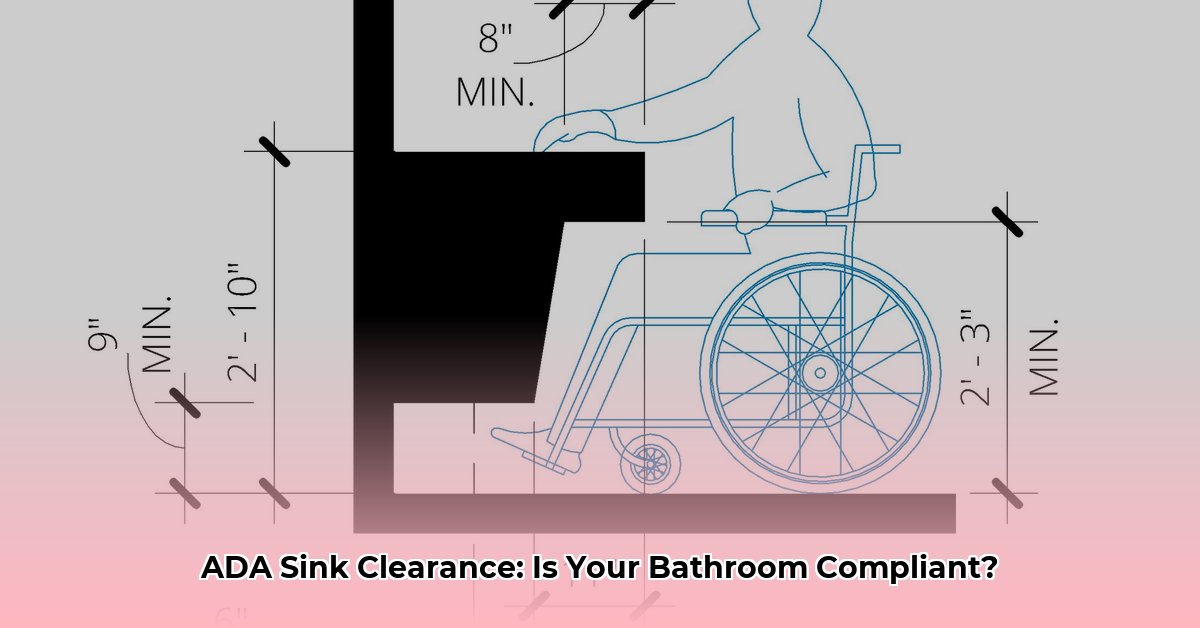Ensuring Accessibility at the Sink
This guide provides detailed instructions on meeting Americans with Disabilities Act (ADA) standards for sinks. Following these specifications ensures comfortable and accessible handwashing for everyone.
Understanding Sink Accessibility
ADA sink requirements focus on providing ample space for users of all abilities, particularly those using wheelchairs or other mobility devices. This includes sufficient maneuvering room, comfortable knee and toe clearance, and reachable controls.
Clear Floor Space: Maneuvering with Ease
A clear floor space is essential for wheelchair users to approach, position themselves, and maneuver around the sink. This unobstructed area should be a minimum of 30 inches wide by 48 inches deep, permitting a forward approach directly in front of the sink. This is the preferred approach for maximum accessibility.
A parallel approach, where the wheelchair is positioned alongside the sink, may be acceptable in specific limited situations. Such applications include employee dining areas, sinks intended for children aged five and under, or other areas where a parallel approach is more practical and still allows safe and independent operation. While acceptable in these specific scenarios, the forward approach generally offers more flexibility and is therefore recommended wherever space allows.
Knee and Toe Clearance: Comfort Under the Sink
Adequate knee and toe clearance under the sink ensures comfortable access for all users. A minimum of 27 inches of clear height, measured from the floor to the underside of the sink, is required for knee clearance. This space must extend at least 17 inches deep, measured from the leading edge of the clear floor space. The depth can extend up to 25 inches.
Toe clearance, the space beneath the sink for feet, must be at least 9 inches high and extend a minimum of 17 inches, typically following along the toe kick at the bottom edge of cabinets. This allows footrests on wheelchairs to fit comfortably and enables users to approach the sink closely.
For children aged 6 to 12, a knee clearance of 24 inches may be acceptable, provided the sink rim or counter is no higher than 31 inches from the floor. This accommodation recognizes the different anthropometric needs of children.
Sink Height and Reach: Promoting Ease of Use
The height of the sink rim or counter, whichever is higher, should not exceed 34 inches from the floor. This height allows both wheelchair users and those standing to comfortably use the sink.
Reach range, the distance from the front edge of the sink to the furthest point a user needs to reach, should not exceed 48 inches. This applies to faucets, soap dispensers, and other controls. If an obstruction, such as a deeper countertop, necessitates a reach over a depth greater than 20 inches, the maximum reach range is reduced to 44 inches to prevent strain.
Faucets and Controls: One-Handed Operation
Faucets and other controls must be operable with one hand and require no more than 5 pounds of force to activate. Designs should avoid tight grasping, pinching, or twisting motions. Lever-operated or touchless (sensor-activated) faucets are generally recommended for ease of use.
Metering faucets, which automatically shut off after a set time, must run for at least 10 seconds to allow sufficient time for handwashing. Touchless or sensor-activated faucets are exempt from this time requirement.
Safety Considerations: Preventing Hazards
Exposed hot water pipes and other potentially hot surfaces under the sink must be insulated or shielded to prevent burns. Sharp edges on plumbing fixtures should also be addressed to minimize the risk of injury. Any design features intended to meet these requirements should not impede the necessary knee and toe clearances.
Measuring for ADA Sink Compliance
Accurate measurements are crucial for verifying ADA compliance. Use a tape measure to confirm the following dimensions:
| Measurement | Requirement |
|---|---|
| Clear Floor Space | 30″ wide x 48″ deep (forward approach) |
| Knee Clearance | 27″ high, 17-25″ deep |
| Toe Clearance | 9″ high, 17-25″ deep |
| Sink Height | ≤ 34″ (rim/counter to floor) |
| Reach Range | ≤ 48″ (≤ 44″ if reach depth > 20″) |
Common ADA Sink Clearance Mistakes
- Obstructed Clear Floor Space: Placing objects like trash cans or towel dispensers within the required clear floor space.
- Insufficient Knee and Toe Clearance: Pipes, cabinetwork, or other fixtures encroaching on the required knee and toe space.
- Excessive Sink Depth: A sink deeper than 17 inches can make it difficult for wheelchair users to reach the faucet and basin.
- Difficult-to-Operate Faucets: Faucets requiring excessive force, tight grasping, or twisting motions.
- Exposed Hot Pipes: Uninsulated or unshielded hot water pipes under the sink pose a burn hazard.
- Exceeding Maximum Sink Height: A sink height greater than 34 inches makes it difficult for many wheelchair users to reach.
Residential and Private Office Exceptions
Some exceptions to these requirements apply in residential settings and private offices used only by one person. For example, removable cabinets under bathroom sinks are permitted, and adjustable kitchen sinks are also allowable provided the plumbing allows for connection at the required minimum heights. However, even with these exceptions, prioritizing accessibility is crucial for creating a welcoming and inclusive environment.
Staying Informed
ADA guidelines are subject to change. Staying current with the latest 2010 ADA Standards for Accessible Design and consulting with a qualified professional ensures compliance and best practices.
Disclaimer: This information is for general knowledge and does not constitute legal advice. Consult a qualified professional for specific guidance on ADA compliance.
- Dora the Explorer Wipe-Off Fun: Safe & Mess-Free Activities for Little Explorers - April 18, 2025
- Does Lemongrass Repel Mosquitoes? Fact vs. Fiction + How to Use It - April 18, 2025
- Do Woodchucks Climb Trees?Fact vs. Fiction - April 18, 2025










